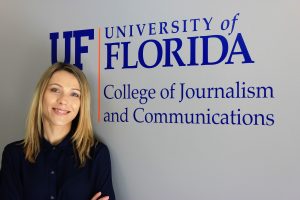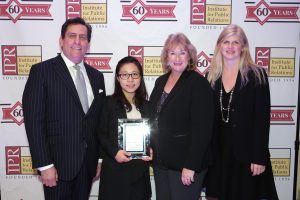The award supports and encourages undergraduate and graduate students interested in applied public relations research as a career opportunity.
What is the award?
The purpose of the Cision Insights Fellowship is to support and encourage undergraduate and graduate students who are interested in applied public relations research as a career. The winners of the fellowship will be given free access to Cision Insights software, which will be used to produce a 2-3 page solo-authored research report or social/traditional media analysis and accompanying blog for publication by IPR. They will also receive guidance and mentorship from an experienced Cision Insights analyst.
The winners of the Fall 2023 Fellowship/Spring 2024 Fellowship will be awarded $1,200 upon completion of the research project. They will also receive a free ticket and travel to the IPR Annual Distinguished Lecture and Awards Dinner on December 4, 2024, where they will be presented with an award onstage by a Cision team member in front of an audience of communications and public relations leaders and academics.
Who May Apply?
Undergraduate students who are at least juniors or graduate students majoring in public relations, communications, or business who have completed at least one methodology course and are studying in person in the United States.
What is Needed to Apply?
To apply, please email the following materials to anetra@instituteforpr.org:
- Copy of resume/CV
- One-page research prospectus that outlines the type of research project you contemplate designing and carrying out, should you be awarded the grant. It is suggested that the student consider the challenges currently facing the public relations and communications profession that can be answered by observing trends in social commentary and/or traditional media coverage though other topics will be acceptable provided that the paper is successful through one of the standard vetting processes for publication on the IPR website. Some topics may include, but are not limited to:
— Communicating the unique impact of public relations to the board room
— How to connect public relations results to business performance
— The role of social advocacy in shaping brand reputation
— Restoring reputation in an environment of extremely low trust
— Models to predict the probability of reputational outcomes
Important Dates:
Spring 2024 Fellowship:
- Application deadline is April 28, 2024.
- The fellow will be selected by May 31, 2024 with onboarding and training to immediately follow
- The solo-authored report must be completed by August 30, 2024.
Fall 2024 Fellowship:
- Application deadline is November 3, 2024.
- The fellow will be selected by January 10, 2025 with onboarding and training to immediately follow
- The solo-authored report must be completed by March 30, 2025.
Fall 2023 Winner:
Morgan Badurak, Louisiana State University

Download Paper (PDF): Is Corporate Social Advocacy the Pathway to Gen Z Engagement? A Case Study of Amazon, SpaceX, and Trader Joe’s Legal Actions Against the NLRB on Social Media
Past Winners

“We have chosen Saymin Lee out of a pool of highly accomplished candidates from esteemed universities across the nation,” said Chelsea Mirkin, Senior Vice President and Head of Global Analysis at Cision Insights. “This achievement is a testament to Lee’s outstanding academic prowess, dedication, and passion for the industry.”
Lee is a doctoral candidate in the University of Maryland’s department of communication. Her research on enterprise actors and how they communicate their emerging technologies is highly anticipated and timely. The final research paper and blog will be published in the IPR Research Letter and on the IPR website in the fall of 2023.

The IPR Cision Insights Research Fellowship committee selects outstanding graduate or undergraduate students in the field of public relations, business, or communications to publish a solo-authored research brief featuring social or traditional media using Cision Insights software and monitoring technology. Fellows receive free access to the Cision Insights software and mentorship from a Cision Insights analyst. Qin will receive her award at the 2022 IPR Distinguished Lecture and Awards Dinner in New York City on December 1.
“We are so excited to have Sunny embedded in our team over the next few months, and look forward to facilitating her research on this important and timely topic, said Chelsea Mirkin, Senior Vice President, and Head of Global Analysis at Cision Insights. “This award is all about building a bridge between the applied research and academic research communities. We appreciate the partnership with the IPR, and the opportunity to help raise awareness amongst emerging graduates on the many different career paths that exist for data-minded communications professionals.”
Qin’s research interests include corporate and leadership communication, relationship management, employee engagement, and corporate purpose and social advocacy. She holds a M.A. in Mass Communication from the University of Florida and a B.A. in Cultural Industry Management from Human Normal University in China.

Download Paper (PDF): The Quest for the California Crown: “Dark” PR Storytelling in the 2021 Newsom Recall Election

Insights award.
“It is my greatest honor to receive the Grunig Cision Insights Research Fellowship this year,” said Shi. “It has been an invaluable opportunity for me to integrate public relations theories with practices through this fellowship.”
Shi completed a research paper based on her time at Cision Insights, titled: “Stepping into Controversial Issues: Corporate Social Advocacy on Facebook and in the Online News.” See the paper here.

Grunig PRIME Research Fellowship recipient. The Institute for Public Relations awards the Grunig PRIME Fellowship on an annual basis, sponsored by PRIME Research, to promote applied communications research as a career choice.
Bajalia spent her fellowship in Ann Arbor Michigan researching measurement within public relations and how PR professionals can better utilize measurement in their practice.
Download Paper (PDF): Tracking Media Metrics Over Time – Bajalia

“It is a great honor for me to become a recipient of the Grunig-PRIME Research Fellowship this year,” said Khalitova. “This accomplishment would have never happened without the help and infinite support of Dr. Spiro Kiousis, the faculty members and staff at the University of Florida, my colleagues Barbara Myslik and Daniel Pimentel, and my teachers at Voronezh State University in Russia. I am grateful to all of them for believing in me, and for everything they have done.”
Download Paper (PDF): Salience_of_CSR_Khalitova
Download Presentation (PDF):CSR_Culture_report_Khalitova_PRIME_IPR_corrected
Download Paper: Reviving the Corporate Brand: McDonald’s Turnaround and Implications for Public Relations/Organizational Communication Sylvia (Jiankun) Guo University of Maryland Grunig PRIME
Institute for Public Relations Annual Distinguished Lecture & Awards Dinner 2016, New York City
Sylvia Jiankun Guo, a Ph.D. candidate at the University of Maryland, has been named the 2016 Grunig PRIME Research Fellowship. The Fellowship, now in its seventh year, promotes applied communications research as a career choice.
“I am both excited and grateful to be selected as the 2016 Grunig PRIME Research fellow,” said Ms. Guo. “I look forward to learning from my fellow researchers and consultants at PRIME, and exploring the business and social value of public relations in the changing media landscape. This fellowship offers a great opportunity to connect research and practice.”

Download Full Paper: Who is Leading Whom in the General Motors Recall: Understanding Media Impact on Public Relations Efforts, Public Awareness, and Financial Markets
EXECUTIVE SUMMARY
Who is Leading Whom in the General Motors Recall: Understanding Media Impact on Public Relations Efforts, Public Awareness, and Financial Markets
Purpose of the Study
The recall by General Motors (GM) in 2014 was one of the largest crises in the history of the automotive industry. According to The Guardian (2014), U.S. Attorney Kenneth Feinberg announced 229 deaths and 1,986 injury claims had been made in December 2014 as more than 16.5 million cars had been recalled for ignition-related defects (Ivory, 2014).
This study investigated the antecedents (i.e., GM trading volume, press releases), agenda-setting (i.e., public awareness) and agenda-building process (i.e., corporate coverage, product coverage), and consequences (i.e., stock price) of news coverage in the GM recall. Agenda-building and agenda-setting theory relate to how influential the media or a corporation are on setting the public or media agenda. After conducting an extensive literature review, the author proposed a model to test the relationships among the variables (see study).
Method
Data were collected from January 1 through December 31, 2014 from four searchable databases including trading volume and share price on Yahoo Finance, press releases on the GM official website, news coverage from Factiva, and public awareness using Google trends. Specifically, data on news coverage were available from PRIME Research, which is one of leading global companies in media analysis since 1987. To analyze the causal relationships among GM trading volume, press releases, news coverage on products and corporations, public awareness, and share price in this crisis, a vector auto regression (VAR) model and pairwise granger causality test were applied for data analysis. These have been widely applied in time series analysis of agenda-setting research.
Discussion and Conclusion
Results revealed that with the context of the GM recall, media coverage was a useful predictor, playing a strong role as an agenda-setter, and could lead to setting of public and organizational agendas. Therefore, the increase of media coverage led to the increase of other variables, for example, and when more coverage emerged, public awareness of this recall event also increased. In this way, media agenda acts as a predictor, or an agenda-setter of the public agenda. Based on the findings, there are three theoretical and practical implications of the results:
Strong impact of media agenda
Data supported the impact that media coverage has on public opinion and corporate brand reputation in a crisis. First, the increasing amount of corporate and product news effectively predicted the increase of public attention toward this recall. The media coverage demonstrated a statistically-significant relationship with public awareness which supported the agenda-setting effects in a corporate crisis context. Second, results also showed the media coverage on GM seemed to influence the organization’s public relations efforts, With the heated discussion on controversial issues (e.g., cost- or customer-oriented GM culture) and an increasing amount of negative news (Himsel, 2014), the media coverage about GM superseded the organization’s desire and ability to lead the agenda under high-risk conditions.
Lack of effects on media agenda
This study also found that GM lacked influence on media coverage, which challenged the traditional wisdom of agenda-building theory. When GM began to conduct more accommodative activities such as expanding recalls significantly in February, apologizing to the public in March, and compensating the victims in June, the tonality of media coverage actually became more negative and generated higher visibility from the general public. Several factors listed below could help explain this phenomena.
The first factor could be the timing for crisis responses. As Huang & Su (2009) suggested, timely crisis responses could successfully improve crisis response effectiveness. In the GM recall, this ignition switch problem first occurred in 2001, however, the company did not report this issue officially. These delayed crisis responses left enough time for large quantities of news reporting to frame the event.
Second, as an organization, GM went through bankruptcy in 2009, reorganized itself, and became a company with a new culture. As the new CEO Mary Barra promised, the new GM was focusing on the safety of customers instead of the cost-driven production in the old GM (Himsel, 2014). However, the restructuring of the company, changes in corporate culture, and the high cost of recalls restrained GM from an active and timely response to the ignition-switch problem, which led to a large amount of negative news coverage before its official responses (Business Insider, 2015).
Third, the nature of the crisis event could constitute another important contingency factor. In the crisis situation, especially within which more deaths occurred, the corporation could easily lose its credibility and draw attention from both media and publics (Sweetser & Brown, 2008). Journalists also attributed the product problem to the corporation itself and intensified the crisis (Putnam & Shoemaker, 2007).
Comparison between corporate and product media coverage.
It was well known that this recall occurred because of the quality of products. However, data showed it was not the products that were most frequently reported by the media. Media coverage on GM corporate led its product coverage in this crisis with larger quantities, more negativity, and higher visibility of reports. Moreover, the corporate media coverage led the organization’s agenda through the crisis and journalists framed this crisis as a corporate management issue rather than only reporting it as a product issue. In this way, although GM had differentiated its brands such as GMC, Buick, and Chevrolet, the public awareness focused on the whole company instead of specific products.
Recommendations for practice:
- Public relations practitioners may proactively and consistently monitor and analyze media coverage on both corporations and products to prevent and manage crises through both online and offline communication.
- GM and other automotive companies might consider applying a more transparent, consistent, thematic, and dialogic communication model at the earliest stages of communication in order to gain trust and retain good stakeholder relationships (Balser & McClusky, 2005).
- Future GM crisis communication strategies should diverge attention from the corporate brand to products by providing a transparent disclosure of information on certain types of products and minimizing the media coverage on the whole corporation.
References
Balser, D., & McClusky, J. (2005). Managing stakeholder relationships and nonprofit organization effectiveness. Nonprofit Management and Leadership, 15(3), 295-315. doi: 10.1002/nml.70
Himsel, D. (2014, May 16). General motors, Avon, and the devastating power of entrenched corporate culture. Forbes. Retrieved from http://www.forbes.com/sites/forbesleadershipforum/2014/05/16/general-motors-avon-andthe-devastating-power-of-entrenched-corporate-culture/
Huang, Y. H., Su, S. H. (2009). Determinants of consistent, timely, and active responses in corporate crises. Public Relations Review, 35 (1), 7-17. doi: 10.1016/j.pubrev.2008.09.020.
Ivory, D. (2014, September 15). G.M.’s ignition problem: Who knew what when. The New York Times. Retrieved from: http://www.nytimes.com/interactive/2014/05/18/business/gms-ignition-problem-who-knew-what-when.html
Putnam, L. L., & Shoemaker, M. (2007). Changes in conflict framing in the news coverage of an environmental conflict. Journal of Dispute Resolution, 1, 167-175.
Sweetser, K. S., Brown, C. W. (2008). Information subsidies and agenda-building during the Israel–Lebanon crisis. Public Relations Review, 34(4), 359-366.
The Guardian. (2014, December 1). Death toll from crashes linked to faulty GM ignition switches rises to 36. The Guardian.Retrieved from: http://www.theguardian.com/business/2014/dec/01/gm-faulty-ignition-switch-car-crashe
![Anna Kochigina [Grunig PRIME Winner]](https://instituteforpr.org/wp-content/uploads/Anna-Kochigina-Grunig-PRIME-179x250.jpg)
Looking forward to enriching her knowledge and demonstrating what she has already learned, Kochigina said she is grateful for the selection committee’s belief in her and the education she received from her university’s faculty.
D
As social media becomes increasingly ubiquitous, organizations are looking for the best way to use these new communication tools. Social media sites like Facebook and Twitter present numerous opportunities to organizations for sharing information, engaging with the public, and monitoring discussion. This article examines the relationship between news values, press releases, and social media. Specifically, the researcher looks at six months of press releases from a Fortune 500 company and relevant posts from the public on Twitter to ascertain whether the number of news values and presence of particular news values in a press release affect the volume and sentiment of conversation on Twitter. The researcher found that certain news values do predict greater conversation and better sentiment on social media, and that a higher number of news values present in a release also predicts a higher volume of conversation on Twitter.
The Relationship between CEO Media Coverage and Overall Organization Media Coverage (PDF)

The findings show a positive relationship between CEO visibility and organization visibility, as well as CEO media tone and organization media tone. A negative relationship was found between CEO media tone and organization media visibility, as well as CEO visibility and organization media tone. The tone of media coverage related to organization strategy, CSR and positioning had the strongest relationship with CEO media tone. The results from this study can inform practitioners what organization stories benefit most from CEO involvement.
APPLICATION

